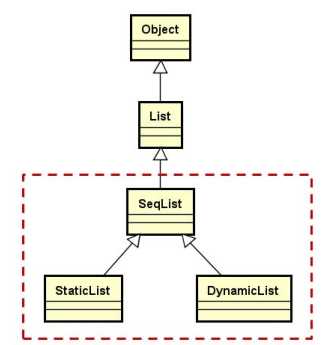标签:seq parameter end bounds cas 数组操作 div protected names

完成顺序存储结构线性表的抽象实现
在SeqList中的关键操作都已经实现了,但它还是一个抽象类,为什么呢?
顺序存储空间的指定并没有在SeqList中完成,由StaticList和DynamicList这两个子类中完成。
SeqList设计要点
——抽象类模板,存储空间的位置和大小由子类完成
——实现顺序存储结构线性表的关键操作(增,删,查,等)
——提供数组操作符,方便快速获取元素
template <typename T>
class SeqList: public List<T>
{
protected:
T* m_array; //顺序存储空间
int m_length; //当前线性表长度
public:
bool insert(int i, const T& e);
bool remove(int i);
bool set(int i, const T& e);
bool get(int i, T& e) const;
int length() const;
void clear();
//顺序存储线性表的数组访问方式
T& operator[](int i);
T operator[] (int i) const;
//顺序存储空间的容量
virtual int capacity() const = 0; //代表顺序存储空间的最大容量,然而顺序存储空间的具体指定并不是在SeqList这个类中完成的。在其子类中实现
};
具体实现:
#ifndef SEQLIST_H
#define SEQLIST_H
#include "List.h"
#include "Exception.h"
namespace DTLib
{
template <typename T>
class SeqList: public List<T>
{
protected:
T* m_array; //该指针指向具体的顺序存储空间,在子类中实现。
int m_length; //当前线性表长度
public:
bool insert(int i, const T& e)
{
bool ret =((0 <= i) && (i <= m_length));
ret = ret && (m_length < capacity() );
if(ret)
{
for(int p=m_length-1; p>=i; p--)
{
m_array[p+1] = m_array[p];
}
m_array[i] = e;
m_length++;
}
return ret;
}
bool remove(int i)
{
bool ret =((0 <= i) && (i < m_length));
if(ret)
{
for(int p=i; p<m_length-1; p++)
{
m_array[p] = m_array[p+1];
}
m_length--;
}
return ret;
}
bool set(int i, const T& e)
{
bool ret =((0 <= i) && (i < m_length));
if(ret)
{
m_array[i] = e;
}
return ret;
}
bool get(int i, T& e) const
{
bool ret =((0 <= i) && (i < m_length));
if(ret)
{
e = m_array[i];
}
return ret;
}
int length() const
{
return m_length;
}
void clear()
{
m_length = 0;
}
//顺序存储线性表的数组访问方式
T& operator[](int i)
{
if((0 <= i) && (i < m_length))
{
return m_array[i];
}
else
{
THROW_EXCEPTION(IndexOutOfBoundsException,"Parameter i is invalid...");
}
}
T operator[] (int i) const
{
#if 0
if((0 <= i) && (i < m_length))
{
return m_array[i];
}
else
{
THROW_EXCEPTION(IndexOutOfBoundsException,"Parameter i is invalid...");
}
#endif
//考虑代码的复用性,那么就可以直接使用上面的非const版本的重载函数。
//此时如果调用到了T operator[] (int i) const,说明当前对象是一个const对象,可以考虑将当前对象的const属性去掉,就可以使用T& operator[](int i)的实现了
return const_cast<SeqList<T&> >(*this)[i];
}
//顺序存储空间的容量
virtual int capacity() const = 0; //代表顺序存储空间的最大容量,然而顺序存储空间的具体指定并不是在SeqList这个类中完成的。在其子类中实现
};
}
#endif // SEQLIST_H
标签:seq parameter end bounds cas 数组操作 div protected names
原文地址:https://www.cnblogs.com/-glb/p/12046474.html